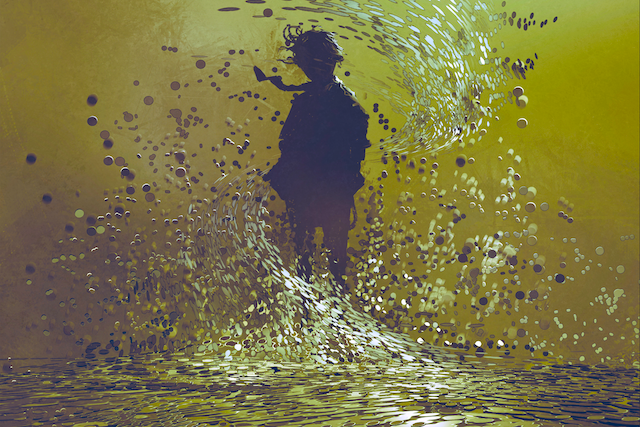It is my observation that in a racialized world, each of us has emotional wounds based on events of ethnic and race-based stress and trauma that are unacknowledged and therefore unhealed. Even though visible and invisible effects of ethnic and racial stress and trauma abound, many of us remain unaware of its effects because it is so common. The challenge of doing the hard work of healing the ancient pain of racial wounding is long overdue.
It is time for each one of us to take an honest look at the wounding we have endured, and the wounding we have inflicted on others, whether intentional or not. We hurt others as a result of ignorance and of our own inner strife and pain. Now is a time for us to turn within and for healing our own pain as if our very lives depended on it because they do.
See also A Yoga Therapist Shares The Truth About Trauma
I believe Restorative Yoga is a tool that can help us do that. It is time for truth and reconciliation. We don’t need to wait for a commission to be formed, or for systems and other individuals to change in order to do this work. This is an inside job. The work I’m talking about is personal. We can begin the process ourselves.
Outer Shifts Begin With Inner Work
In order to effect social change, we have to approach the task of educating ourselves and of healing our internal wounds with courage, dedication, and devotion.
But the work we have to do goes beyond policy changes, diversity and inclusion initiatives, and laws. The work we have to do requires shifts in consciousness and it starts with individual personal transformation. No law or policy can make that happen. It is time to shine a light on our own ethnic and racial wounds and to begin the process of healing ourselves. This new revolution is going to be internalized, not broadcast or televised. Now is a time for a change of heart, change that occurs from the inside out.
See also A Guide to Navigating True Transformation
Restorative Yoga for Ethnic and Race-Based Stress and Trauma is unique because it invites people of all races, ethnicities, cultures, and nationalities to examine how living in a racialized world affects each of us: from the stress and trauma of the daily lived experiences of racial wounding that people endure, to ‘white fragility’—“a state in which even a minimum amount of racial stress becomes intolerable, triggering a range of defensive reactions” (DiAngelo 2011, p.57).
Why Yoga?
The purpose of yoga is to alleviate pain and suffering and to minimize it in the future. Over time it began to dawn on me that Restorative Yoga had a great deal to offer when it came to easing the emotional pain and suffering brought on by ethnic and race-based stress and trauma. Handling difficult life situations with composure is an important skill to hone. Dealing with race and ethnicity skillfully is critically important in a multiracial, multiethnic, multicultural world. Yoga practices, particularly Restorative Yoga, have much to offer when it comes to dealing with highly charged emotional issues like race and ethnicity. When we practice Restorative Yoga, we are teaching our nervous system how to release contraction and to feel safe coming into deep states of rest that support repair, rejuvenation, and resilience. We are developing a nervous system with a buffer, while strengthening our psychological immune system.
When we learn to experience our emotional pain and discomfort without contracting around it and reacting to it, and instead just let it move through us, our nervous system becomes regulated and we become emotionally regulated.
See also Emotions in Motion
This means our nervous system is in a state of homeostasis, or balance, allowing us to see with more clarity, and we become grounded in a sense of well-being. As this happens, our responses to ethnic and racial offenses become wiser, more functional, and more effective.
This Restorative Yoga sequence is designed to support stillness and comfort to help quiet the nervous system and restore balance between the fight-flight (sympathetic) response and the rest-digest (parasympathetic) response. A focus on breath while silently repeating “I breathe in rest, I breathe out resilience” supports balancing the nervous system and can offer respite and recovery from race related stress and trauma. Bolsters, blankets and blocks are used to increase comfort so poses can be held for extended periods of time, between five and 20 minutes for each pose.
Select one or all four poses depending on how much time you have. Firm pillows, can substitute for bolsters, and cushions or books can substitute for blocks. Finding your edge in a Restorative Yoga practice is based on how much stillness and comfort you can tolerate, not on how much effort you are making.
See also 31 Yoga and Self-Care Resources for Black Yogis (Especially if Social Media Has You Overwhelmed)
See also Escape to Supported Child's Pose
" data-full-src="https://www.yogajournal.com/.image/ar_3:2%2Cc_limit%2Ccs_srgb%2Cfl_progressive%2Cq_auto:good%2Cw_700/MTczMDExMTg0NDYxNTU1MjMy/gail-2.jpg" data-image-id="ci0266a8c1900124ec" data-image-slug="gail-2" data-public-id="MTczMDExMTg0NDYxNTU1MjMy" data-srcset="https://www.yogajournal.com/.image/ar_3:2%2Cc_limit%2Ccs_srgb%2Cfl_progressive%2Cq_auto:good%2Cw_320/MTczMDExMTg0NDYxNTU1MjMy/gail-2.jpg 320w, https://www.yogajournal.com/.image/ar_3:2%2Cc_limit%2Ccs_srgb%2Cfl_progressive%2Cq_auto:good%2Cw_700/MTczMDExMTg0NDYxNTU1MjMy/gail-2.jpg 700w, https://www.yogajournal.com/.image/ar_3:2%2Cc_limit%2Ccs_srgb%2Cfl_progressive%2Cq_auto:good%2Cw_960/MTczMDExMTg0NDYxNTU1MjMy/gail-2.jpg 960w, https://www.yogajournal.com/.image/ar_3:2%2Cc_limit%2Ccs_srgb%2Cfl_progressive%2Cq_auto:good%2Cw_1400/MTczMDExMTg0NDYxNTU1MjMy/gail-2.jpg 1400w" data-sizes="(min-width: 675px) 700px, 100vw" data-thumbnail="https://www.yogajournal.com/.image/c_fill%2Ccs_srgb%2Cg_face%2Ch_80%2Cq_auto:good%2Cw_80/MTczMDExMTg0NDYxNTU1MjMy/gail-2.jpg" data-title="Supported Balasana">See also These 10 Yoga Bolsters are Perfect for a Restorative Home Practice
" data-full-src="https://www.yogajournal.com/.image/ar_3:2%2Cc_limit%2Ccs_srgb%2Cfl_progressive%2Cq_auto:good%2Cw_700/MTczMDExMTg0NDYxNjIwNzY4/gail-11.jpg" data-image-id="ci0266a8c190002620" data-image-slug="gail-11" data-public-id="MTczMDExMTg0NDYxNjIwNzY4" data-srcset="https://www.yogajournal.com/.image/ar_3:2%2Cc_limit%2Ccs_srgb%2Cfl_progressive%2Cq_auto:good%2Cw_320/MTczMDExMTg0NDYxNjIwNzY4/gail-11.jpg 320w, https://www.yogajournal.com/.image/ar_3:2%2Cc_limit%2Ccs_srgb%2Cfl_progressive%2Cq_auto:good%2Cw_700/MTczMDExMTg0NDYxNjIwNzY4/gail-11.jpg 700w, https://www.yogajournal.com/.image/ar_3:2%2Cc_limit%2Ccs_srgb%2Cfl_progressive%2Cq_auto:good%2Cw_960/MTczMDExMTg0NDYxNjIwNzY4/gail-11.jpg 960w, https://www.yogajournal.com/.image/ar_3:2%2Cc_limit%2Ccs_srgb%2Cfl_progressive%2Cq_auto:good%2Cw_1400/MTczMDExMTg0NDYxNjIwNzY4/gail-11.jpg 1400w" data-sizes="(min-width: 675px) 700px, 100vw" data-thumbnail="https://www.yogajournal.com/.image/c_fill%2Ccs_srgb%2Cg_face%2Ch_80%2Cq_auto:good%2Cw_80/MTczMDExMTg0NDYxNjIwNzY4/gail-11.jpg" data-title="Supported Salamba Bharadvajasana (Side Twist)">Gail Parker is a psychologist, a certified yoga therapist, and a yoga therapist educator. She is a lifelong practitioner of yoga for 50 years. As a practicing psychotherapist of 40 years, she pioneered efforts to blend psychology, yoga, and meditation as effective self-care strategies that can enhance emotional balance, and contribute to overall health and well-being.
© 2020 Singing Dragon. Reprinted with permission. Learn more at singingdragon.com. This article may not be reproduced for any other use without permission. Illustrations by Justine Ross.








